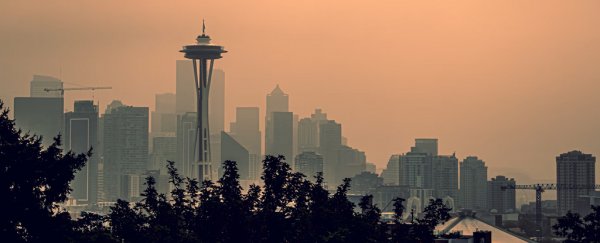We often take the air we breathe for granted, but new data reveals that the pollutants behind millions of preventable deaths now taint the air most of us breathe at unhealthy levels.
"Air pollution has an impact at a much lower level than previously thought," says World Health Organization technical officer Sophie Gumy, in reference to WHO's recently updated air quality guidelines.
Based on an analysis of air pollution data covering more than 6,000 cities in 117 countries, WHO says 99 percent of the world's population now breathes air that does not meet the updated safety guidelines. This covers 80 percent of the world's urban areas.
With each breath, invisible nitrogen dioxide (NO2) from vehicles, construction equipment, industrial boilers, power plants, and so on, flows deep into our lungs. There, it can irritate our delicate airway tissues, causing increasing inflammation, triggering allergies, and asthma and reducing lung function.
NO2 also greatly increases the risk of developing childhood asthma. It has also been associated with lower weight in newborns, as well as cardiovascular disease, even with short term exposure.
We also inhale fine particulate matter (PM) carried by the air, made up of many different substances including natural desert dust as well as all sorts of pollutants from microplastics, cooking fires, industry, agricultural activities, burning fossil fuels, and wildfires. WHO is monitoring particulate matter with diameters equal or smaller than 10 μm (PM10) or 2.5 μm (PM2.5).
"Particulate matter, especially PM2.5, is capable of penetrating deep into the lungs and entering the bloodstream, causing cardiovascular, cerebrovascular (stroke) and respiratory impacts," says WHO. "There is emerging evidence that particulate matter impacts other organs and causes other diseases as well."
While developing nations still struggle with particulate matter to a greater extent than wealthy nations – with the highest recorded levels of PM10 in India and PM2.5 in China – that difference is not so clear when it comes to NO2.
Globally, only 23 percent of people across the 4,000 cities measured breathe NO2 levels that are within WHO's safety guidelines, with the highest concentrations found in the Mediterranean.
Shocking!
— World Health Organization (WHO) (@WHO) April 4, 2022
99% - or almost the entire world's population breathes air with unhealthy levels of fine particulate matter & nitrogen dioxide, and threatens their health.
More: https://t.co/Llaj2wHk0V #HealthierTomorrow pic.twitter.com/QlHUP4iyS4
Last month, another large-scale air quality report by Swiss company IQAir came to similar conclusions, finding no country met WHO's air quality guidelines for PM2.5 in 2021.
Climate change-fueled wildfires contributed to the US experiencing a spike in PM2.5 air pollution compared to 2020, the IQAir team found. Lower-income communities in the US typically suffered the most air pollution, and the US city with the worst pollution was Los Angeles.
The good news is that many cities in China showed improvement in air quality last year, but they still have a long way to go. Developing countries face additional challenges around cooking and heating fires, as well as industry.
"It is a shocking fact that no major city or country is providing safe and healthy air to their citizens according to the latest World Health Organization air quality guideline," says Frank Hammes, CEO of IQAir.
"This report underscores just how much work remains to be done to ensure that everyone has safe, clean and healthy air to breathe. The time for action is now."
Both reports indicate almost all of us face an increased risk of heart disease, stroke, lung disease, and cancer because of these pollutants. WHO estimates outdoor pollution was responsible for around 4.2 million premature deaths in 2016, from PM2.5 alone.
WHO notes fossil fuels produce the most harmful emissions linked to both acute and chronic sickness, as well as exacerbating conditions that trigger greater natural pollutants like bushfires and dust storms. The organization urges for widespread and systemic reductions in their use.
The solutions happen to be the same as those we desperately need to apply to tackle the climate crisis: switch to electric vehicles, use more public transport, converting to renewable energy, and practicing sustainable development and agriculture.
"Current energy concerns highlight the importance of speeding up the transition to cleaner, healthier energy systems," says WHO Director-General Tedros Adhanom Ghebreyesus.
"High fossil fuel prices, energy security, and the urgency of addressing the twin health challenges of air pollution and climate change, underscore the pressing need to move faster towards a world that is much less dependent on fossil fuels."
While fossil fuels may still be stubbornly viewed as the most convenient form of energy, despite cheaper, healthier options, the new data demonstrate that most of us are risking our health every day to pay for them.
WHO's Air Quality Database 2022 report can be read here.
